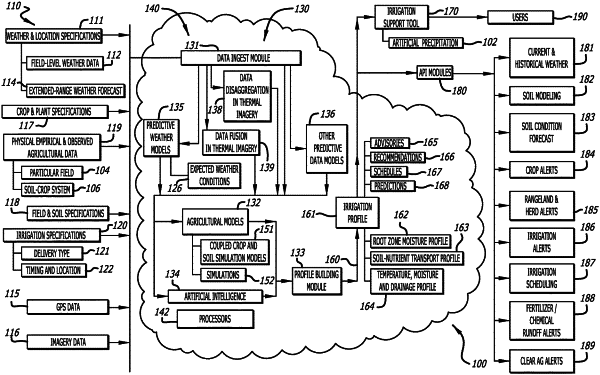| CPC A01G 25/167 (2013.01) [A01B 79/005 (2013.01); A01G 25/023 (2013.01); G01W 1/10 (2013.01); G06F 30/20 (2020.01)] | 33 Claims |

|
1. A method, comprising:
ingesting, as input data, weather and climatological information that includes at least one of historical field-level weather data and extended-range weather forecast data, field and soil specifications data, nutrient profile and application data, and crop specific information relative to a particular field;
modeling the input data in a plurality of data processing modules within a computing environment in which the plurality of data processing modules are executed in conjunction with at least one specifically-configured processor, the data processing modules configured to assess moisture and nutrient states of a soil-crop systems in the particular field, by
1) diagnosing and predicting expected weather conditions at or near the particular field from the weather and climatological information, 2) aggregating the expected weather conditions with the crop-specific information into coupled crop and soil simulations models of physical and empirical characteristics impacting the moisture and nutrient states at one or more root zone depths within the soil-crop system, and configured to simulate moisture flows that affect a transport of at least one of a nutrient applied to, or a nutrient resident within, the soil-crop system, and 3) generating a soil-nutrient density and transport profile for the soil-crop system in the particular field based on simulated moisture flows, representing the moisture and nutrient states at the one or more root zone depths over time for the one or more crop growth stages; and
developing an artificial intelligence model to analyze a specific time-varying water deficit model for the soil-crop system, wherein the artificial intelligence model builds a comprehensive dataset for the coupled crop and soil simulation model of physical and empirical characteristics impacting the moisture and nutrient states at one or more root zone depths within the soil-crop system to predict the moisture and nutrient states in a soil-crop system in any field at any selected time, and wherein the comprehensive dataset comprises generating automatic associations between the input data and the soil-nutrient density and transport profile for the transport of the nutrient to a specific root zone depth in the particular field;
adjusting one or more parameters in the soil-nutrient density and transport profile based on the comprehensive dataset generated by the artificial intelligence model; and
developing a schedule from the soil-nutrient density and transport profile for transport of the nutrient to a specific root zone depth in the particular field, wherein a user effects the transport of the nutrient to the specific root zone depth based on the schedule or an automated transport of the nutrient to the specific root zone depth is controlled based on the schedule.
|